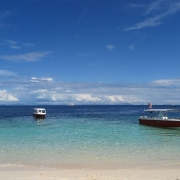What is the Free Aceh Movement?
Topic of Study [For H2 History Students]:
Paper 2: Search for Political Stability
Section B: Essay Writing
Theme I Chapter 2: Approaches to National Unity
Historical Background
Aceh is located in the north-western tip of Sumatra. Notably, the Acehnese supported the practice of Islam. In the 1950s, Aceh rallied behind the Darul Islam rebellion, which resulted in a partial acceptance by the Sukarno government to grant a ‘special region’ status for Aceh. It was seen as an accommodative response by the government, enabling the Acehnese to manage their own matters relating to religion, education and customary law.
To put an end to the violence, Aceh was granted the status ‘Special Region of Aceh’ (Daerah Istimewa Aceh) in 1959, supposedly having autonomy in matters pertaining to Religion, Education and Customary law. However, most Acehnese claim that this ‘special status’ is a farce because on most occasions, the central government in Jakarta enforces its national laws, even when these laws completely contradict local customs. For example, in the late 1980s when the central government announced a national anti-jilbab (veil) policy – Aceh was also forced to bow down to national policy.
An excerpt from “Gender, Islam, Nationalism and the State in Aceh: The Paradox of Power, Co-optation and Resistance” by Joy Aquino Siapno.
However, problems began to surface due to growing discontent over two reasons. First, the transmigration policy involved the relocation of workers from the overpopulated Java to other islands, including Aceh. Consequently, Javanese immigrants occupied the mountains and industrial zones on the Aceh coast, cutting off Acehnese access to fish and rice for subsistence.
Second, public discontent related to the distribution of Aceh’s natural resource. Although the Aceh supplies thirty percent of Indonesian oil and natural gas by the late 1980s, it was still one of the poorest provinces in the country.
Free Aceh Movement
A former Darul Islam leader Hasan di Tiro formed the Free Aceh Movement (Gerakan Aceh Merdeka) in December 1976. The separatists aimed to create an independent Islamic state. GAM went through four key phases, the late 1970s, 1980s, 1990s and early 2000s as result of military operations launched by Jakarta. Under Suharto’s New Order, the Indonesian army (Tentera Nasional Indonesia, TNI) mobilised its troops to quell the separatist insurgencies from the late 1970s to 1990s.
Tensions continued to rise, and in 1989, the civil war resumed. Attempts to negotiate a settlement with the Scandinavian-based exiled leadership were halfhearted at best. The war was bloody and very costly for GAM, with several thousand members killed. The TNI increased its presence in the province throughout the 1990s, reaching a peak of thirty thousand troops (the police were part of the army until 1999).
[…] GAM’s fourth phase began in 1999 with a renewed offensive to take advantage of the collapse of the Suharto regime/military-backed government. The system of civilian administration by the military ended, though civil administration was very weak. The military was on the defensive for human rights abuses and its role in keeping Suharto in power, so GAM seized the initiative and launched a wave of attacks. GAM truly believed that Indonesia was on the cusp of being a failed state and that independence was inevitable.
An excerpt from “Forging Peace in Southeast Asia: Insurgencies, Peace Processes, and Reconciliation” by Zachary Abuza.
Peaceful resolution and an unexpected national disaster
In December 2002, GAM and the Indonesian government signed a Cessation of Hostilities Agreement, allowing for temporary ceasefire between the parties. Although the agreement broke down, GAM ceased hostilities after a massive earthquake in the Indian Ocean occurred on 26 December 2004, which caused a tsunami that affected numerous Acehnese. Both the GAM and government focused on providing humanitarian relief to the affected people.
In February 2005, another round of peace talks were held in Finland. Five months later, a peace deal was finally reached, ending the three decade-long insurgency.
The Government of Indonesia (GoI) and the Free Aceh Movement (GAM) confirm their commitment to a peaceful, comprehensive and sustainable solution to the conflict in Aceh with dignity for all.
The parties commit themselves to creating conditions within which the government of the Acehnese people can be manifested through a fair and democratic process within the unitary state and constitution of the Republic of Indonesia.
The parties are deeply convinced that only the peaceful settlement of the conflict will enable the rebuilding of Aceh after the tsunami disaster on 26 December 2004 to progress and succeed.
An excerpt from “Memorandum of Understanding between the Government of the Republic of Indonesia and the Free Aceh Movement”, 15 August 2005.
What can we learn from this article?
Consider the following question:
– How far do you agree that minority responses were most important in affecting government efforts to forge national unity?
Join our JC History Tuition to learn more about the Approaches to National Unity. The H2 and H1 History Tuition feature online discussion and writing practices to enhance your knowledge application skills. Get useful study notes and clarify your doubts on the subject with the tutor. You can also follow our Telegram Channel to get useful updates.
We have other JC tuition classes, such as JC Math Tuition and JC Chemistry Tuition. For Secondary Tuition, we provide Secondary English Tuition, Secondary Math tuition, Secondary Chemistry Tuition, Social Studies Tuition, Geography, History Tuition and Secondary Economics Tuition. For Primary Tuition, we have Primary English, Math and Science Tuition. Call 9658 5789 to find out more.











